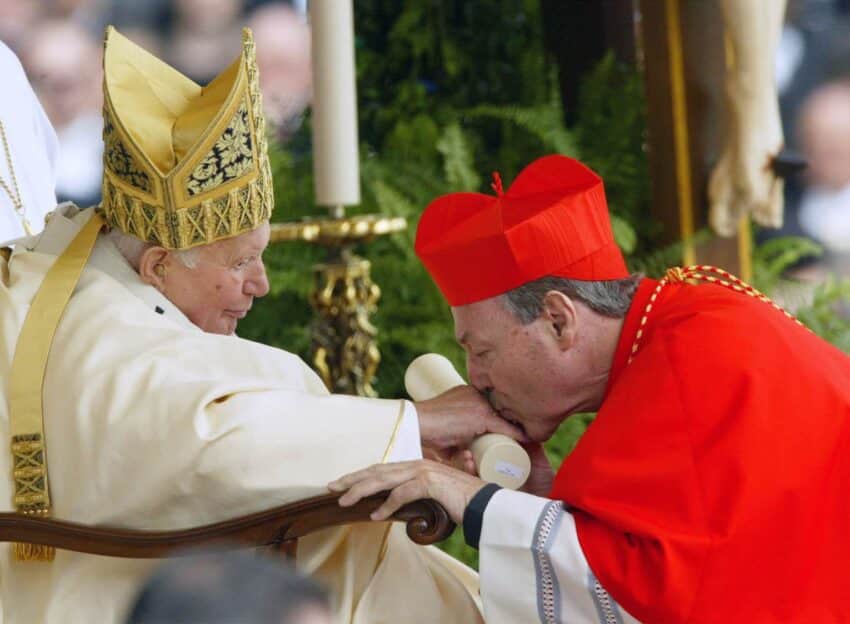
After the sudden death of Cardinal George Pell, the adulation and denigration have settled down. Friends and foes agree that he had an impact on the Church and society, indeed challenging people of faith to rise above earthly sufferings and limitations. Therefore, at this stage studying his legacy might better be called appreciating “The Pell Effect”.
The Challenge of the Secularists
When I lived with him in the archbishop’s house (1997-2001), as two historians, we discussed modern secularisation. Is it a threat or an invitation? I was pessimistic about the rise of secularism in Australia and the West and its destructive effect on religion and on families. He was more optimistic, arguing that people, especially Australians, are still basically religious.
We were both well-versed in the Vatican II teaching on the nature, freedom and dignity of the human person, cf. Gaudium et Spes, chapter 1. Inspired by Bob Santamaria, we both valued democratic society and parliamentary government. Therefore part of the Pell Effect is the challenge always to be alert to threats to our freedom, whether sliding towards totalitarianism or by conforming to that ”fascism of the mind”, political correctness. He knew that religion is the true guardian of freedom, so he calmly faced the new atheism in his debate with Professor Dawkins, inviting us to engage directly with atheism, not to retreat to some safe corner.
He had a great concern for persecuted Christians, intensified during his work for Caritas and his support for Aid to the Church in Need. Among his heroes were cardinals who suffered under Communism: Mindszenty in Hungary, Wyszyniski in Poland and Stepanic in Croatia. He was a friend and supporter of Cardinal Zen of Hong Kong, who dined in his apartment after the funeral of Pope Benedict.
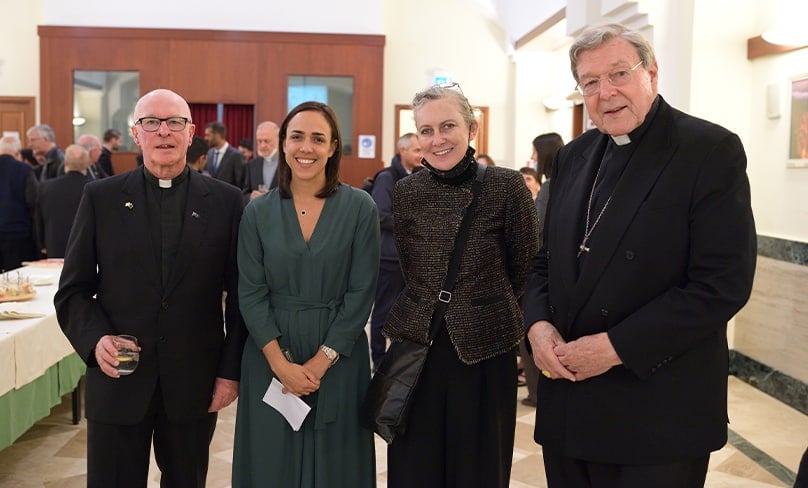
“Be not Afraid”
Another Pell Effect emerges through his capacity to face life with courage. I believe this began with his love of sport, particularly rowing, cricket and above all football.
This Australian Rules ruck man (partly converted to Rugby) was not afraid of anyone. Barreling down the field in seminary days, another student rebuked him, “George how can you talk about the love of God when you’re such a bastard in footie?” His gruff reply was: “Don’t bring religion into sport.”
However, as he entered priesthood and worked in various pastoral appointments, he became aware that some people were afraid of “big George”. This explains why, as the new Archbishop of Melbourne, he took the words of Our Lord as his motto: “Be not afraid!” At the same time the motto expressed his vision of a courageous Church, God’s People united in orthodoxy and living tradition but not afraid to go forward, to innovate and break new ground, to “launch out into the deep”, as St John Paul II put it. But in relating to people, he never lost the skills learnt in the family pub, able to talk to anyone, to move freely from small talk to lofty matters, and always with a sense of humour.
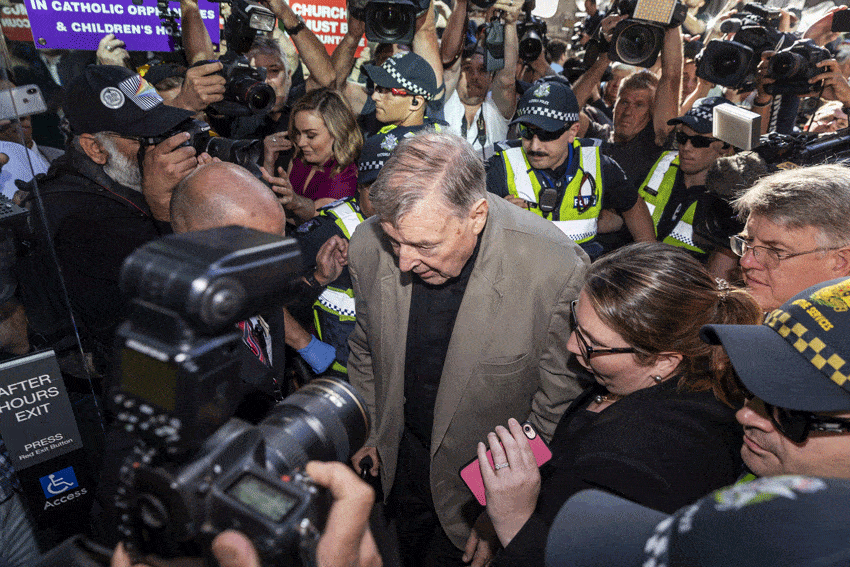
The Trials
Another element in the Pell Effect emerged during his persecution, a call to persevere in times of trial and testing. And he knew what that involved.
The vehemence of aggressive interrogation at commissions and the narrative of his trial lifted the lid off a concealed cesspool: Anti-Catholicism in Australia. He endured biased legal processes in Victoria, with lies and calumny hurled at him because he was a Catholic bishop. He had to listen to pernicious absurdities, that the Church is to blame for pedophilia, or the bigoted suggestion that he lived in a palace when his only abode in Rome consisted of two rooms in Domus Australia! Finally, he was put on trial for an impossible and obscene allegation.
An effect of his own persecution was also to expose the collapse of basic principles of Law in society, such as the presumption of innocence and “beyond reasonable doubt”. In Victoria, we witnessed the breakdown of the separation between the executive and judicial arms and the apparent entanglement of some police in a political conspiracy. But it all may be traced back to the Vatican. Having served in the Roman Curia for ten years, I may know something about what can happen there.
When Pope Francis called him to the Vatican to clean up the money, he was immediately in danger, as his sister Margaret perceived. He was not welcome. At the time, a retired Italian official who worked in the Secretariat of State, ranted in my face, “Your Pell does not understand our way of doing things!” He soon became the cardinal who knew too much about “our way of doing things”. So he had to go. Then unfolded the saga of his being framed, tried and jailed.
Yet he did not slide into self-pity or bitterness. He enjoyed the unstinting support of his family and friends, and the respect of his guards, as I noted when I visited him in prison. He welcomed expert legal advice that finally led to the favourable decision of the High Court. Above all, in prison the chance to deepen his life of prayer consoled him, as his published diaries reveal. Here the Pell Effect becomes a spiritual example for all of us to follow, a reminder that, in suffering, what counts is union with God.
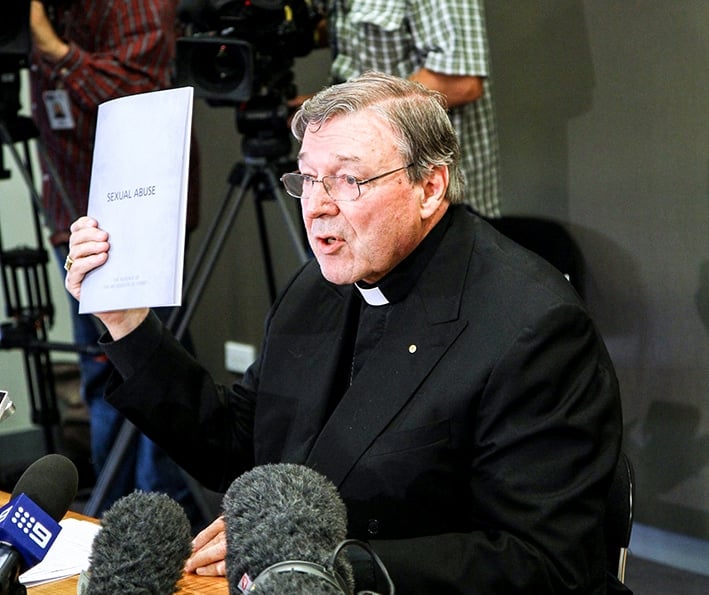
The Abuse Issue
The most controversial area of the Pell Effect focuses around the issue of the abuse of children in the Church, Here he did make mistakes, for example in the mishandled Ellis case in Sydney. Yet it is incongruous that he, of all bishops, would become the scapegoat for other people’s sins, because he was the pioneer of listening, redress, care and support for victims. His Melbourne Response was set in place soon after he became archbishop in 1996.
It was not a perfect response but it meant something at a time when other bishops did little. They seemed frozen in the face of an evil they could not comprehend. Then the national redress scheme Towards Healing was widely adopted, but it was the Pell approach that paved the way for a better pastoral approach to the suffering and hurt of victims. That should never be forgotten.
Education
The Pell Effect is obvious when we turn to the field of the education of children and young people. At all levels his inspiration was another hero, Archbishop Daniel Mannix.
This massive dimension of the Pell Effect invites a book that would have to cover his concrete achievements. It might begin with his successful renewal of Aquinas College for teacher training in Ballarat. This was followed by the task of revitalising Corpus Christi College, seminary of the Province of Victoria and the Archdiocese of Hobart.
While his seminary work was cut short when he was ordained Auxiliary Bishop in 1987, he returned to it once he became Archbishop of Melbourne. He relocated the seminary to Carlton with a new rector, Msgr Aldo Rebeschini, former secretary to Cardinal Knox. Msgr Charles Portelli set up a magnificent gothic chapel as the prayerful heart of a compact campus. More importantly, the formation of future priests was now in line with the provisions of the Second Vatican Council. At the same time, working with the other Bishops, he revitalised theological education for seminarians. The Catholic Theological College was built in an elegant modern style on the site of the cathedral college and it was open to anyone who sought theological education.
His relations with the Australian Catholic University were not always good. But once he became the Archbishop of Melbourne, he consolidated its campuses into a central St Patrick’s Campus, near the cathedral. As Archbishop of Sydney he enjoyed a better relationship with ACU and he greatly valued his friendship with Prof Greg Craven.
When he went to Sydney, he secured a campus site for the University of Notre Dame. He believed this was the time to bring it beyond Fremantle and to enter into a healthy competition with ACU. This has been a successful project.
From the time of its inception he supported Campion College, as its founder, Karl Schmude attests. He was already a friend of the John XXIII Fellowship, which became the Campion Fellowship, inspiring the foundation of a liberal arts Catholic college, located in the Diocese of Parramatta. Again, we see his trust in lay initiatives, and his respect for the intellect in the wider Catholic traditions, Eastern and Western. The English martyr St Edmund Campion was another of his heroes.
However, he also founded the Melbourne Session of the John Paul Institute for Marriage and Family, derived from the mother institute in the Lateran University Rome, where I completed my doctorate. This was the jewel in the crown. I was privileged to be director of the institute in its last years when, to his horror, it was closed. And nothing has replaced it.
He was also aware of the educative value of pilgrimages to Rome so he established Domus Australia in the shell of an abandoned religious house and gave free rein (and ample funds) to Msgr Charles Portelli to restore and enrich its noble church. At last, thanks to the Pell Effect, Australians have their own centre in Rome. Pope Benedict was pleased to come and open Domus Australia.
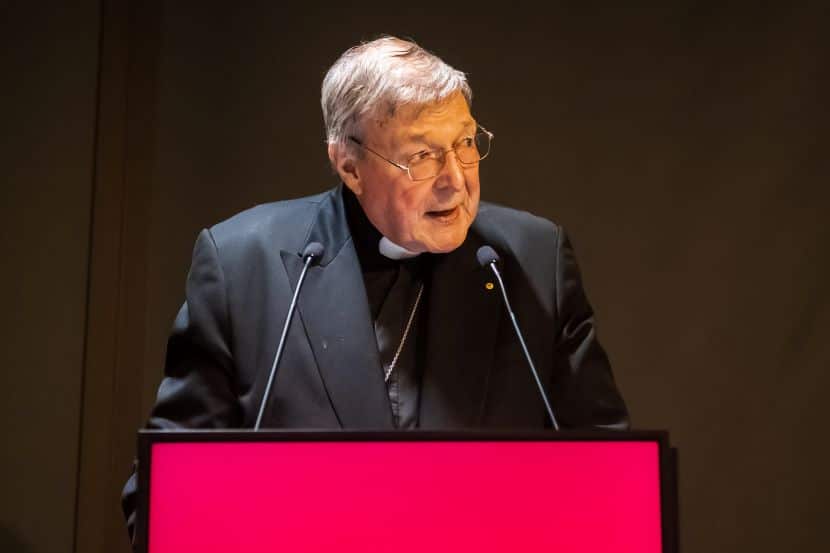
Religious Education
His work for education began at a personal level with his rapport with children and young people, or “youngsters” as he called them. He enjoyed engaging children in lively Confirmation catechesis, as witnessed by Bishop Tony Ireland. He engaged in a lively debate with my twelve-year-old niece over Queen Elizabeth I. Her little brother chimed in with a negative comment on Mary Tudor. He enjoyed every minute of it. He wanted children to be articulate and informed, and this applied particularly to religious education.
Well before George Pell became a bishop he wrote a pamphlet about the Post-Vatican II collapse of religious education, Bread, Stones or Fairy Floss. He called for more substantial “bread”, rejected cold old stones, and wrote off the fairy floss of the dominant “life situation” catechetics. He had to wait until he was Archbishop of Melbourne to achieve what may well be a lasting element in the Pell Effect. In 1997 he called me back from Vatican service to edit 13 text books for primary and secondary schools, in a series entitled To Know, Worship and Love. Not without controversy, the books appeared and were mandated in Melbourne and several other dioceses. They came with him to Sydney and became a joint project, much improved by Sydney expertise. Now they are online, hence in use in many schools around Australia.
He insisted that the texts should also impart Catholic culture and be beautiful, hence including many works of art. He was already open to what was later called the “catechesis of beauty, affirmed by Pope Benedict and endorsed by Pope Francis.
His appreciation of beauty began with music, inspired by his violinist sister, Margaret. He valued the visual arts, evident in the water garden at St Patrick’s cathedral Melbourne, in the chapel in the Melbourne seminary, in the church of Domus Australia, and, in a more austere style, in the chapel of the St Benedict Retreat Centre he established near Sydney. I would be less certain of his concept for the new altar he installed in St Mary’s cathedral, but we avoided that topic.
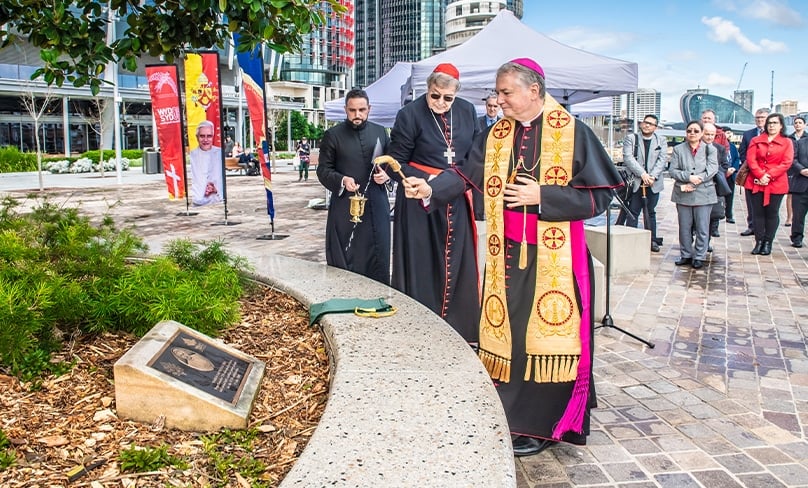
Loyalty and Leadership
Cardinal Pell expected loyalty from the many women and men who worked with him and he sought to be loyal himself, even when it became difficult. Therefore, while he has rightly criticised “synodality”, I doubt whether he authored a “secret document” challenging Pope Francis. He never discussed Pope Francis with me. He was deeply loyal to the papacy.
During a Mass he celebrated at World Youth Day in Sydney in 2008, he told the young people that, “Nine hundred years ago before there was a king in England, there was a Pope in Rome.” Some have interpreted those teaching words as Irish nationalism, not so. While George Pell was a republican, he was also an Anglophile who deeply admired Queen Elizabeth II for her loyalty to God and her people.
How then are we to sum up all these complex dimensions that combine in the Pell Effect? One word seems to encapsulate what the cardinal meant to the Church in Australia – Leadership. So his sudden passing to eternal life challenges us, both in the Church and in society. Where now is such leadership?
